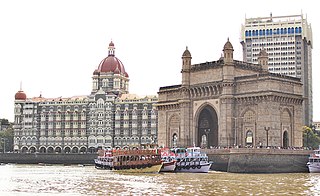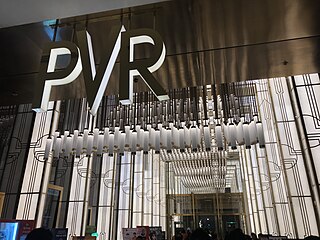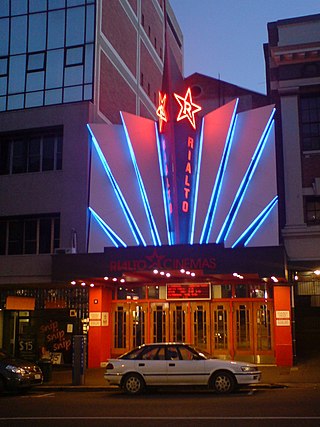
A resident of Mumbai is called a Mumbaikar. People prefer to stay close to a railway station for easy access to the metropolis. Many city-dwellers lead a fast-paced life with very little time for other activities owing to a significant amount of time spent on daily commuting.
Odeon Cinemas Limited, trading as Odeon, is a cinema brand name operating in the United Kingdom, Ireland, Norway and Greece, which along with UCI Cinemas and Nordic Cinema Group is part of the Odeon Cinemas Group subsidiary of AMC Theatres. It uses the famous name of the Odeon cinema circuit first introduced in Great Britain in 1930. As of 2016, Odeon is the largest cinema chain in the United Kingdom by market share.

Metro INOX Cinemas is an Art Deco Heritage grade IIA multiplex Movie theatre in Mumbai, India built in 1938. It was built and originally run by Metro-Goldwyn-Mayer (MGM). The main architect of the cinema was Thomas W. Lamb of New York City, and D. W. Ditchburn of Mumbai was the associate architect. It was one of the main sites targeted in the 2008 Mumbai attacks.

Chennai architecture is a confluence of many architectural styles. From ancient Tamil temples built by the Pallavas, to the Indo-Saracenic style of the colonial era, to 20th-century steel and chrome of skyscrapers. Chennai has a colonial core in the port area, surrounded by progressively newer areas as one travels away from the port, punctuated with old temples, churches and mosques.

PVR INOX Ltd, formerly known as PVR Cinemas, is an Indian multiplex chain based in Delhi. It was formed as a result of the merger between PVR Cinemas and INOX Leisure Multiplex. PVR pioneered the multiplex revolution in India by establishing the first multiplex cinema in 1997 at Vasant Vihar, New Delhi. In 2022, PVR Cinemas achieved the milestone of completing 25 years in the business. As of December 2023, PVR Inox has 1747 screens across 359 properties in 114 cities.
Cinépolis is a Mexico-based international movie theater chain. Its name means City of Cinema and its slogan is La Capital del Cine.

The Eros Cinema is an Art Deco style cinema theatre located in Cambata Building at Churchgate, Mumbai, India. It has a seating capacity of 1,204 people per show.
Two Odeon cinemas were formerly located in Leeds, West Yorkshire, England:
The architecture of Mumbai blends Gothic, Victorian, Art Deco, Indo-Saracenic & Contemporary architectural styles. Many buildings, structures and historical monuments remain from the colonial era. Mumbai, after Miami, has the second largest number of Art Deco buildings in the world.

Liberty Cinema is an Art Deco 1200 seater single screen Movie theatre in Mumbai, India. Since the cinema was built in 1947, the year of Indian Independence, its founder Habib Hoosein decided to name it "Liberty". Liberty screens Bollywood Hindi movies. David Vinnels and Brent Skelly describe Liberty Cinema as "an exquisite jewel box of rococo decoration enhanced by a coloured lighting scheme suggesting a fairyland far away from the bustle and tumult in the streets outside" in their book Bollywood Showplaces: Cinema Theatres in India. On the fifth floor of the Liberty Cinema building there is a small 30 seater hall, Liberty Mini. Decorated with art from the pre-independence period, it is used for press previews and private screenings. Liberty has been the location of movie premiers of several movies, such as Mughal-e-Azam.

John Stanley Coombe Beard FRIBA, known professionally as J. Stanley Beard, was an English architect known for designing many cinemas in and around London.

Sterling Cineplex is a multiplex cinema hall in Mumbai. Opened in 2007, Sterling has three screens and was the first cinema in India to be THX certified. It is considered a landmark in South Mumbai.

Metro Cinema or Metro Cinemas is a uniplex cinema hall and a heritage building located in Jawahar Lal Nehru Road (Esplanade), Kolkata, West Bengal, India. This theatre was opened by Metro-Goldwyn-Mayer in 1935. It is currently owned by a Mumbai-based firm and is undergoing a renovation to be converted into a multiplex theatre. The building is located in the posh Esplanade area of Kolkata, right at the heart of the city. It is a heritage structure and a very famous landmark of the city of Kolkata. And one of the many famous cinema halls in the Esplanade area of Central Kolkata.
Lighthouse Cinema was a single screen cinema hall and heritage building located in Humayun Place in New Market, next to New Empire, Kolkata, West Bengal, India.

The Rialto Cinema is a multiplex cinema located in the New Zealand city of Dunedin. It was opened in 1998.

The Rio Cinema is a Grade II listed independent Art Deco cinema in Dalston, east London. It is a popular independent cinema located on Kingsland High Street, with a history stretching back over 100 years. The Rio added a second screen in the unused basement space in December 2017.

The Deco is a restored 1930s cinema and theatre located in the heart of Northampton, England. It is now operated as a venue for corporate, social and theatrical events.

Kashmiri cinema is the Kashmiri language-based film industry in the Kashmir Valley of the India,- administered union territory of Jammu and Kashmir. The first Kashmiri feature film, Mainz Raat, was released in 1964. In 2023, Welcome to Kashmir, directed by Tariq Bhat, became the first Kashmiri-produced Bollywood film to release in Kashmiri cinemas.

The Art Deco in Mumbai, India style is a notable feature of the architecture of the city. It was used primarily for office buildings, residences and movie theaters, during a period when India was part of the British Empire. On 30 June 2018, an ensemble of such buildings were officially recognized as a World Heritage site by the UNESCO World Heritage committee held in Bahrain as the Victorian and Art Deco Ensemble of Mumbai.















